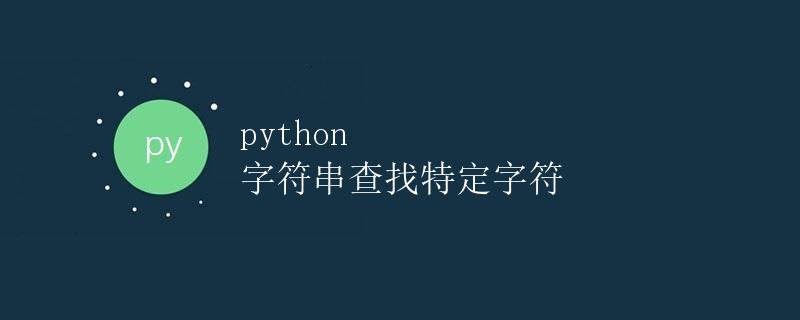Python 字符串查找特定字符

在 Python 中,字符串是不可变的序列,可以通过索引来访问字符串中的每一个字符。有时候我们需要查找字符串中特定的字符,以便进一步处理或分析数据。本文将重点介绍如何在 Python 中查找字符串中特定字符的方法和技巧。
使用 in 关键字查找特定字符
Python 中的 in 关键字可以用于判断一个字符是否存在于字符串中。如果存在,则返回 True,否则返回 False。我们可以利用这个特性来查找字符串中特定的字符。
# 示例代码
my_string = "Hello, world!"
char_to_find = "o"
if char_to_find in my_string:
print(f"The character '{char_to_find}' is found in the string.")
else:
print(f"The character '{char_to_find}' is not found in the string.")
上面的代码将输出:
The character 'o' is found in the string.
使用 find() 方法查找第一个特定字符的位置
除了使用 in 关键字判断字符是否存在于字符串中,我们还可以通过字符串的 find() 方法找到第一个特定字符的位置。find() 方法会返回字符在字符串中的索引,如果字符不存在,则返回 -1。
# 示例代码
my_string = "Hello, world!"
char_to_find = "o"
char_position = my_string.find(char_to_find)
if char_position != -1:
print(f"The first occurrence of '{char_to_find}' is at index {char_position}.")
else:
print(f"The character '{char_to_find}' is not found in the string.")
运行上面的代码将输出:
The first occurrence of 'o' is at index 4.
使用 rfind() 方法查找最后一个特定字符的位置
如果我们需要查找字符串中最后一个特定字符的位置,可以使用 rfind() 方法。rfind() 方法类似于 find() 方法,但是从字符串的末尾开始查找。
# 示例代码
my_string = "Hello, world!"
char_to_find = "o"
char_position = my_string.rfind(char_to_find)
if char_position != -1:
print(f"The last occurrence of '{char_to_find}' is at index {char_position}.")
else:
print(f"The character '{char_to_find}' is not found in the string.")
运行上面的代码将输出:
The last occurrence of 'o' is at index 8.
使用 index() 方法查找第一个特定字符的位置
和 find() 方法类似,index() 方法也可以用来查找字符串中第一个特定字符的位置,不过如果字符不存在,index() 方法会引发 ValueError 异常。
# 示例代码
my_string = "Hello, world!"
char_to_find = "o"
try:
char_position = my_string.index(char_to_find)
print(f"The first occurrence of '{char_to_find}' is at index {char_position}.")
except ValueError:
print(f"The character '{char_to_find}' is not found in the string.")
运行上面的代码将输出:
The first occurrence of 'o' is at index 4.
使用 rindex() 方法查找最后一个特定字符的位置
类似于 rfind() 方法,rindex() 方法可以用来查找字符串中最后一个特定字符的位置,如果字符不存在,则引发 ValueError 异常。
# 示例代码
my_string = "Hello, world!"
char_to_find = "o"
try:
char_position = my_string.rindex(char_to_find)
print(f"The last occurrence of '{char_to_find}' is at index {char_position}.")
except ValueError:
print(f"The character '{char_to_find}' is not found in the string.")
运行上面的代码将输出:
The last occurrence of 'o' is at index 8.
使用 count() 方法统计特定字符出现的次数
除了查找特定字符的位置,有时候我们还需要统计字符串中特定字符出现的次数。Python 的 count() 方法可以帮助我们实现这个功能。
# 示例代码
my_string = "Hello, world!"
char_to_count = "l"
char_count = my_string.count(char_to_count)
print(f"The character '{char_to_count}' appears {char_count} times in the string.")
运行上面的代码将输出:
The character 'l' appears 3 times in the string.
使用正则表达式查找特定字符
除了上面介绍的方法外,我们还可以使用 Python 的 re 模块来利用正则表达式查找字符串中特定的字符。正则表达式能够更加灵活地匹配字符串,适用于更加复杂的查找需求。
下面是一个示例代码,使用 re 模块查找字符串中所有的数字:
import re
my_string = "Hello, 123 world! 456"
numbers = re.findall(r'\d', my_string)
print(f"All numbers in the string are: {numbers}")
运行上面的代码将输出:
All numbers in the string are: ['1', '2', '3', '4', '5', '6']
总结
本文介绍了在 Python 中查找字符串中特定字符的几种方法,包括使用 in 关键字、find() 方法、rfind() 方法、index() 方法、rindex() 方法、count() 方法以及正则表达式。根据需要选择合适的方法来查找字符串中的特定字符,让我们能够更加高效地处理和分析数据。
 极客教程
极客教程